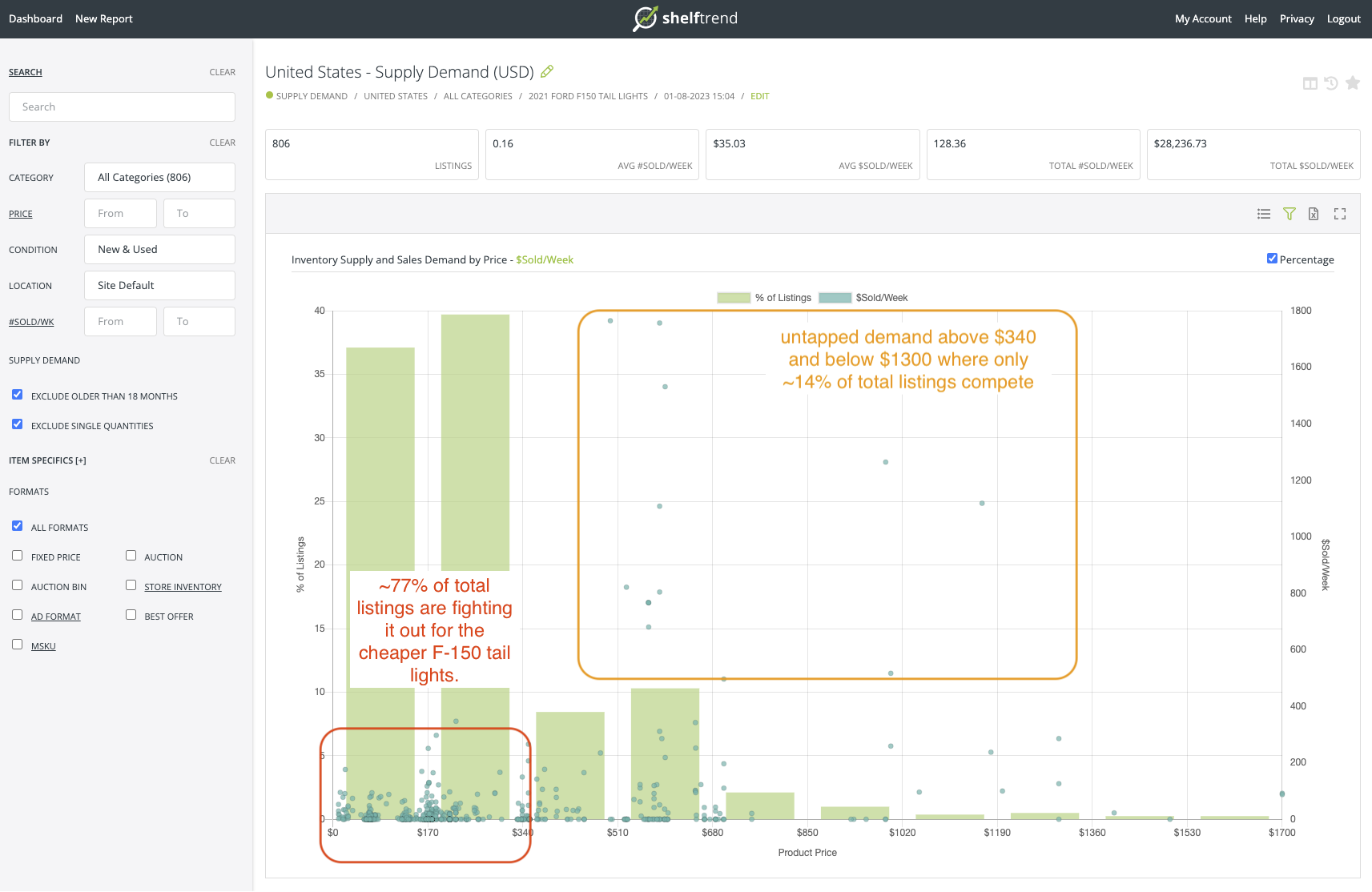Our team has analysed thousands of categories and interviewed as many sellers since 2006 and the most successful businesses never want to be late entering a category.
This is because untapped category opportunities are vital for e-commerce sellers aiming to stay ahead and build sustainable businesses on competitive channels like eBay, Amazon or other marketplaces. In popular e-commerce categories, sellers are in a price war, offering lower-priced items that are easily accessible. This copy cat tactic is often a one way ticket to lower profits and higher operating costs.
While the top e-commerce sellers may stock and sell lower or negative profit items (called loss leaders) they always look to have a broader product mix to appeal to more buyers. These businesses invest time discovering new untapped categories with limited competition, allowing them to innovate new product ideas and reach new buyer segments willing to pay more for added value.
For example, consider the below live inventory data in a popular category like "Ford F-150 tail lights" on ebay.com. The Supply Demand Chart shows potential for untapped demand between $340 and $1300 where only ~14% of products compete for higher $ sales per week.
In contrast ~77% of products are fighting it out for the cheaper F-150 tail lights less than $340
As an e-commerce seller these untapped category opportunities can be the key to sustainable growth and differentiation in the competitive market. Embrace the challenge, leverage data insights, challenge your suppliers and test and learn your way into bigger profits
It can be a slower and more involved path to product ideas than copying other sellers but the rewards can be worth the effort.
Here are 8 ideas and resources to get you started
Creative Brainstorming for Market Gaps:
Think about your personal interests, passions, and experiences. Consider problems that you or your target customers encounter in their daily lives. Seek inspiration from unique angles and untapped niches. Talk to as many potential shoppers as possible and remember, finding a market gap is about discovering unmet needs or addressing existing pain points.
DIY product research:
Tools like ShelfTrend empower e-commerce entrepreneurs with real-time data from major online marketplaces like eBay at a low subscription cost. These services can help you identify future state white space in a category and visualise what products could be created, bundled or discounted to cater to gaps in the market.
Hire a product researcher:
If you don’t have time to do product research hire a freelancer on Fiverr or similar service marketplace to help propose product ideas. Working with a reliable analyst can be a game-changer for e-commerce sellers, providing them with valuable market intelligence and a competitive edge while bringing in a fresh set of ideas that you and the people close to your business operations may not spot.
Challenge your supplier:
Your supplier or manufacturer have obvious incentives to find or create new product proposals to bring you. Empower them with data reports and this will open up a more informed dialogue and better quality product offerings being presented to you that fits in the white space. The most proactive suppliers may even contribute a resource to run the supply demand report for you on a regular basis
Private Label creation
Creating your own brand to differentiate and build capital with customers is a proven strategy. It allows you to brand products manufactured by a third-party supplier as your own. Look for generic products that are in demand but not yet branded by any specific company. Customize the packaging and branding and most importantly improve the product with new features if possible to create a unique selling proposition for your customers
Stay Updated on E-commerce News and Trends:
Subscribe to industry newsletters, follow e-commerce news websites, and read blogs related to your niche regularly. Staying informed about the latest trends, consumer preferences, and market shifts will help you make informed decisions about product selection and sourcing.
Join E-commerce Forums and Communities:
Participate in e-commerce forums, online seller communities, and social media groups dedicated to e-commerce. Engaging with experienced sellers in these communities can help you gain valuable insights into successful product niches, effective marketing strategies, and trustworthy sourcing options.
Attend E-commerce Conferences and Webinars:
Keep an eye out for e-commerce conferences, webinars, and workshops. These events often feature industry experts who share valuable knowledge about the latest trends, niche opportunities, and sourcing strategies. Networking with fellow attendees can also provide you with valuable contacts and potential business partnerships.
Embrace the challenge and let these market gaps become stepping stones to your e-commerce success.
Whatever your business goals, ShelfTrend is the go-to-market research tool used by over 60,000 online sellers, agencies and freelance consultants to easily;
Get visibility of what over 170 million buyers are purchasing from the world’s largest marketplace
Analyse category product range, pricing and sales strategies.
Easily find an untapped product niche with proven sales.
Quantify business issues and add context to your situation through benchmarking.


